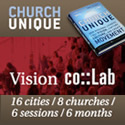Megachurches: The Concerns
- Posted by: Todd
- Posted on: Fri, September 09, 2005
- Viewed 119
- (21) comments so far
1. Large churches are tempted to make "the show" the thing. Can it always be said that a worship service must be a major production of Hollywood quality? I attended workshops at the Ginghamsburg Church, a Methodist mega-church near Dayton, where they gave us insight into worship planning. It came across as a production meeting for a live TV show, which, for all intents and purposes, it was. As a result, what should be a participatory experience of worship becomes a show. I keep thinking about all those passages in the prophets where God lets Israel know he despises their shows (sacrifices and feast days) because their heart really isn't right.
2. Large churches are tempted to "compromise" for the sake of numbers. Whether or not some of our mega-churches have abandoned the Restoration Movement's strong stand on biblical authority, there is a tendency to "soften" the rhetoric. Now that's not all bad, but when the motive for softening the rhetoric is to avoid offense doesn't it become an effort to merely "tickle ears"? Then there is the motive that undergirds the effort. All too often "we want to sound like everyone else" so others will think "we're like everyone else." Israel got in trouble with that when they wanted a king like everyone else. You see, if we sound like evangelicals or good Baptists, the evangelicals and the Baptists will stop accusing us of being a cult or being something really wierd like "water regenerationists." Then everyone will "like us" and more will come to our services.
3. Large churches confuse relationship with discipleship. Sunday School or Bible School is passe at least for adults. The important thing is establishing relationships. The theory is that those who make friends (relationships) stay. Its more than a theory, it is a truth and every church needs to develop means by which its members can develop relationships. But let's be honest about it. The main concern here is "shutting the back door" and retaining members so the numbers look good. Christian formation is a secondary concern. So the mega-churches downplay Sunday School -- after all, building facilities for adult classes is expensive -- and emphasize Small Groups. I am uncategorically for small groups, but small groups are for relationship building and accountability. They do not and cannot teach biblical content nor do they effectively stimulate genuine discipleship. Discipleship has to do with "forming Christ in me." Somehow the early church passed on content as well as developed biblical relationships. How did they do it? The model is found in 2 Timothy 2:2. Somebody qualified taught others. Church leaders and teachers responsibly passed on correct doctrine. Part of that doctrinal teaching had to do with "loving one another as I [Christ] have loved you."
4. Large churches are vision oriented rather than people-oriented. In many, but not all, cases the vision boils down to the ABCs of church life -- Attendance, Buildings, and Cash. The church becomes a corporate structure with directors (elders) and officers (the staff) and a CEO (the senior minister). The vision shapes the programs and the success of the program is measured in Attendance, Buildings, and Cash. The few whose lives really do change become "poster boys or girls" for what the program can do, but the real success is measured by "the many" rather than "the few." What ever happened to the New Testament picture of an elder as a shepherd? The word poimene, or pastor, is a word applied to the elder rather than the preacher (unless, of course he is also an elder). It is time for the church to get back to the biblical picture of an elder as shepherd and care-giver rather than executive. The same goes for the preacher and his staff!
5. Large churches often assimilate their culture rather than affect the culture. Although the early church always faced cultural challenges from without, the wide-spread acceptance of Christianity exacerbated the problems. When thousands poured into the church after Constantine, they brought with them many of their heathen practices and ideas. In many cases, the church merely "baptized" those practices and made them somewhat Christian. Since those days, the church has continued to assimilate the culture. According to Wolfe's The Transformation of the American Church, today's church has become so encrusted with the culture it is hardly different. Barna reports that moral conditions within and without the church are roughly equivalent. Somehow the church has forgotten its calling to be "a peculiar people." We use the culture's music, the culture's methods, and the culture's values to market our product but the product is often confused with that offered by today's cultural gurus.
6. Large churches equate "feeling" with commitment. One of the staff members from Southeast Christian Church told me that when they got into their most recent structure, there was an attendance jump of about 3,000 a Sunday. Those making decisions streamed down the aisle in record numbers leaving those responsible for assimilation feel overwhelmed. When asked why they had responded to the invitation, many of those who came said "they wanted to be part of an exciting church." "Just once," I was told, "I would lie to hear someone say they came forward because they wanted to make Jesus Lord." In my view, that's quite an indictment. You see, the feeling of excitement and the dynamics of a service motivated decision rather than commitment to Christ. We are often told that today's people want to feel God or experience God in their worship. These statements represent an emphasis on feeling rather than commitment. You see, one can go home feeling good, feeling excited, and feeling motivated but when the feelings die then .... You see, there is little genuine contentment in a feeling. In my view, real commitment means accepting a truth and when that truth is accepted and lived out then things feel right!
7. Large churches can become sources of pride. While I rejoice over every individual brought to Christ in our larger churches (or smaller ones for that matter), our tendency to list and display "our mega-churches" is rapidly becoming a source of pride. We are pointing to the fact that Restoration mega-churches, by percentage, out pace the mega-churches of every other religious group in this country. In other words, by percentage of congregations there are more Christian Church mega-churches than Baptist mega-churches, or Nazarene mega-churches, or Methodist mega-churches. We are close to saying, "See what we have done!" Others may think, "God must be blessing us more than others because we have more mega-churches by percentage than any other group." Didn't our chests expand a bit when we heard some of the major media noted that the Christian Churches and Churches of Christ were the second fastest growing religious group in the USA, right behind the Mormons!!
Again... any comments you'd like to share?
Michael Hines has a great blog and he recently did a very well thought-out piece on megachurches. He listed seven positives about megachurches and seven concerns he has about large churches. I thought we’d break this down into a two-part series since there is some great stuff here. Yesterday, we looked at the positives; today we look at his concerns…
Comments
if you want a Globally Recognized Avatar (the images next to your profile) get them here. Once you sign up, they will displayed on any website that supports them.






Bernie Dehler on Tue, September 20, 2005
Todd-
I do and don’t have problems with mega-churches. For example, I’ve never visited Calvary Chapel Costa Mesa, but it might be defined as a mega-church. Of all the Christian denominations, Calvary Chapel is my favorite. Maybe I’m naive, but maybe they are large because they are so right-on.
Gerry, about Willow Creek, I have no idea… no personal in-depth knowledge of them… or Saddleback.
What really sickens me is the churches that want to be large, for largeness sake. There’s a lot of false humility and ego problems underlying it all.
Let me boil it down to this mindset: if you want to grow thru multiplication, plant a church. If you want to grow by addition, build a mega-church. What problem do you have with that statement?
Another reason why I tend to HATE megachurches, in general, is because they tend to promote “Churchianity” rather than true Christianity (corrupting the Gospel). Keeping the main institution alive takes so much money and time that outreach is severely affected. Then they bring in false teaching about tithing in order to bring in money, to add insult to injury. From experience, they usually also have a “big tent” mentality, which means tolerating all kinds of evil teachings like the prosperity gospel, because they don’t want to offend anyone (the donors).
...Bernie
http://www.oneplace.com/ministries/247
Todd Rhoades on Tue, September 20, 2005
It would be interesting to really run the comparison between the small churches who cater to the ones who are giving the money; and the large churches who cater to the ones who are giving the money. My guess is (only because I’ve seen it over and over and over again)… many (if not most) churches are run by two committees: Finance and Property; and those people very much ‘protect their own’ if you know what I mean. Or if you want to read it this way: they ‘protect the donors’.
Helena on Wed, September 21, 2005
#1. The Bible calls for the church to have order. I think the mega churches need to prepare for services like a production - it would be difficult to pull off a service that involves so many people and so many aspects unless it is highly organized. As long as the actual service is only like a production in the preparation aspect alone. If properly organized before-hand, the service itself should have the freedom to be a wonderful, Spirit-filled and - yes, flexible - time with the Lord.
#5 I believe our faith and doctrine is what makes us a peculiar people, not the music we use in expressing it or any other cultural aspect - as long as it doesn’t compromise our belief system or contradict the Word, it should be okay.
Thanks everyone for such great comments and insight. The Church should consistantly be examining itself to make sure it is without spot or blemish and these were great topics to mull over. God bless you all and thanks for all the great comments.
Charles George on Tue, September 27, 2005
There is usually good content in pulpit ministry, especially in larger churches, but the dynamic between Pastor and people is effective if and when the Pastor is visiting his people in their homes and work-places, building relationships and getting to know their needs. Then and only then can sermon preparation/planning/prayer be what it should be. Up-front talent and resulting entertainmentism/cultic Pastor-worship is replacing spiritual shepherding.
Tim on Mon, October 17, 2005
Being a member of a mega church, I would have to agree with most, if not all of what was said in this article. The one thing I would like to add is that many of the mega churches I have observed are “program” driven. They play to the wants and needs of the people. They are able to offer programs that small churches cannot due to their budget. In a “me” driven society this is very appealing. It is also interesting to note that the Pareto Principle still applies even in the mega church. Twenty percent of the people are still doing eighty percent of the work. People love to say they are members of the mega church, and love what it offers them. However, the problem that exists in churches of all sizes still persists. Until we all come to the point where we say, “I love what I can do for the church and God”, and not, “I love what the church can do for me” we will never have strong and vibrant churches that glorify God. In all the comments on this article I rarely saw where anyone argued the fact that God was at work in their church. No matter the size of your church, just allow God to be the focal point and do His work, and not just look busy.
S.B. on Mon, March 12, 2007
I don’t think the megachurch model has any real positives that are unique to that paradigm. It appears to be mammon-compromised. The critical question is, what really gave birth to the model? Spiritual or economic concerns? 501(c)3s, faith-based “initiatives” - these are economic-political concerns. Entirely.
Page 2 of 2 pages < 1 2
Post a Comment